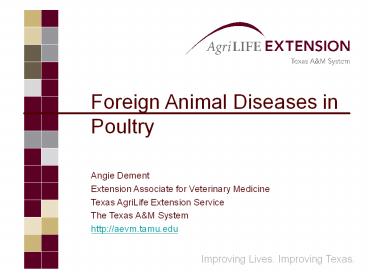Foreign Animal Diseases in Poultry PowerPoint PPT Presentation
Title: Foreign Animal Diseases in Poultry
1
Foreign Animal Diseases in Poultry Angie
Dement Extension Associate for Veterinary
Medicine Texas AgriLife Extension Service The
Texas AM System http//aevm.tamu.edu
Improving Lives. Improving Texas.
2
(No Transcript)
3
Avian Flu Bird Flu
- Viral disease
- Two classifications or forms
- Low-pathogenic avian influenza (LPAI)
- risk to poultry industry
- reportable
- endemic disease
- most common class
- High-pathogenic avian influenza (HPAI)
- serious damage to poultry industry
- reportable
- epidemic disease
- Disease severity and symptoms determine class
4
- Zoonotic disease (Rare)
- HPAI class
- Mutates potentially infectious to people
- limited bird to people via bird feces
- unusual people to people
- not a pandemic (global) human flu
- 115 human deaths (1/04-5/06) SE Asia
- Human Flu 36,000 human deaths/yr US
5
- Vaccines under development
- Antiviral drugs available
- Accelerated monitoring and surveillance
- Advanced diagnostic technologies
- Advanced information delivery technologies
6
- Affects many bird species
- Chickens
- Turkeys
- Pheasants
- Quail
- Geese
- Ducks
- Guinea fowl
7
Causative Agent
- Caused by influenza strain A virus
- Over 144 subtypes of type HN
- by combinations of H and N
- H Hemaglutinin
- N Neuraminidase
- examples H1N2, H2N2, H7N2
8
- Types H5 and H7
- mutates from LPAI to HPAI
- FAD (not in US)
- Subtype H5N1 (epidemics)
- HPAI
- bird to bird, rarely to people
- Asia
- Subtype H7N7 (epidemics)
- HPAI
- bird to bird, rarely to people
- The Netherlands
- Various Subtypes of HN (endemics)
- LPAI
- bird to bird, not to people
- US
9
- Virus denatured by
- Heat
- Proper cooking
- Drying
- Most disinfectants/detergents
10
Transmission
- Natural reservoir
- Migratory waterfowl
- Virus in intestines
- Virus shed in feces
11
- One gram of contaminated manure can contain
enough virus to infect1 million birds.
12
- Bird - bird direct contact
- Feces
- fecal to oral transmission most common
- Saliva
- Nasal excretions
13
- Bird environment - bird indirect contact
- Mechanical contamination
- Environmental transmission
- Manure
- Equipment
- Vehicles
- Egg flats
- Crates
- People articles
14
Diagnosis
- LPAI
- No symptoms
- Low-risk virus
- HPAI
- Symptoms
- Sudden death before symptoms
- High-risk virus
- virulent
- highly infectious
- respiratory disease
15
- Symptoms
- Sudden death
- Lack energy/appetite
- Decreased egg production
- Egg deformities
- Swellings
- Red and purple skin
- Nasal discharge
- Coughing/sneezing
- Incoordination
- Diarrhea
16
(No Transcript)
17
(No Transcript)
18
(No Transcript)
19
Prevention
- BIOSECURITY!
- Lock houses
- Special clothing
- Dont visit other houses
- Control visitors
- Cleanliness
- Submit sick birds
- Dispose of dead birds
- Restricted area signs
- No live-bird market birds
- Sanitary/disinfectant protocols
20
Regulation and Eradication
- Texas FEAD Response Plan
- identify positive animals and destroy
- reduce amount of time to get back test results
- track origin of suspect animals
- LPAI
- quarantine
- may destroy birds (depopulation) with evidence of
mutation - disinfect premises
- HPAI
- quarantine
- destroy birds (depopulation)
- disinfect premises
21
Exotic Newcastle Disease
- Previously known as Velogenic Viscerotropic
Newcastle Disease (VVND) - Viral disease
- Affects all bird species
- Highly contagious
- Most infectious poultry disease
- Reportable
- Zoonotic
22
Causative Agent
- Virus
- Serotype group Avian paramyxovirus type 1
(APMV-1) - Highly resilient
23
Transmission
- Virus excreted by
- Feces
- Nose
- Mouth
- Eyes
- Virus enters by
- Ingestion
- Inhalation
24
(No Transcript)
25
- Spread by
- Direct contact
- Mechanical means
- Human contamination
- Incubation period is 2 to15 days
- Highly contagious in all bird species
- Some birds die without symptoms
26
Diagnosis
- Clinical signs include
- Respiratory
- Digestive
- Nervous
- Egg production
- Swelling
- Death if flocks are not vaccinated, death rate
will be 100 if animals become infected
27
(No Transcript)
28
Prevention
- Maintain biosecurity measures
- No pet birds
- Diseased birds to diagnostic lab
- Know health status of birds before bringing them
to farm
29
(No Transcript)
30
Regulation and Eradication
- Texas FEAD Emergency Response Plan
- identify positive animals and destroy
- reduce amount of time to get back test results
- track origin of suspect animals
31
- 1 response procedure is to destroy an infected
flock and impose a strict quarantine. - Clean entire premises
- Wait 30 days before repopulating
- Control insect/rodent population
32
- Deactivate virus by
- Sun exposure (UV rays)
- Rapid dehydration
- The virus can survive for weeks in warm, humid
environments and indefinitely on frozen material.
33
Poultry Biosecurity
- Keep Your Distance
- Keep It Clean
- Dont Haul Disease Home
- Dont Borrow Disease From Your Neighbor
- Know the Warning Signs of Infectious Bird
Diseases - Report Sick Birds
34
Questions

